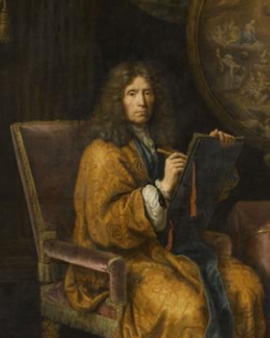Pierre Mignard was born in France in the city of Troyes as the son of a family of craftsmen. His father was Pierre Mignard sen., his mother Marie née Gallois. He had an older brother Paul who also became a painter. The youngest member of the family was apprenticed to the painter Jean Boucher in Bourges. Later he moved to Paris. In the nearby castle Fontainebleau he copied the paintings of famous artists. At the age of about 23 Pierre Mignard went to Rome, where he lived and worked for over 22 years. He created many paintings, mainly on mythological and religious themes. Especially often he painted the Madonna with Child or altarpieces with saints. He also made commissioned copies of the works of his compatriot Nicolas Poussin. He also discovered his enthusiasm for portraits and painted portraits of various popes, cardinals and other higher dignitaries of the Vatican, but also Italian noblemen and wealthy citizens. Well-known works from this creative period include "The Virgin with the Grapes", "The Holy Family with St. John the Baptist in a Classical Landscape", "The Presentation of the Virgin Mary in the Temple" and "Death and Cleopatra".
In 1657 the now very famous artist received an invitation to Paris, probably from Cardinal Mazarin, a minister of the French King Louis XIII and papal diplomat. During a stopover in Avignon, Mignard met the famous dramatist Moliere, of whom he later painted several portraits and who became a close friend. Arriving in Paris, the painter was received with enthusiasm by society. He soon had many influential patrons who had their portraits painted by him. These included, for example, the commander Turenne, the philosophers Bossuet and Descartes and the royal mistresses Montespan, La Valiere and Maintenon. Louis XIV, the Sun King, also held the artist in high esteem and posed for him several times. Piere Mignard was the undisputed star among Parisian painters at the time and even deposed the king's first painter, Charles Le Brun, from the throne. The artist died in 1695, just as he had just accepted a major artistic work on the dome of the Dome of the Invalides.
Art critics today assume that Pierre Mignard was one of the most successful portrait painters of the time, but not one of the best.
×





.jpg)
.jpg)
.jpg)
.jpg)
.jpg)
.jpg)
 Count of Toulouse late 17th century - (MeisterDrucke-91467).jpg)
 Count of Toulouse late 17th century - (MeisterDrucke-91467).jpg)
.jpg)
.jpg)
.jpg)
.jpg)
.jpg)
.jpg)
 Countess of Grignan - (MeisterDrucke-74546).jpg)
 Countess of Grignan - (MeisterDrucke-74546).jpg)
.jpg)
.jpg)
.jpg)
.jpg)
_Jean_Baptiste_Poquelin_Oil_on_canvas_Dim_055_x_0_-_(MeisterDrucke-984031).jpg)
_Jean_Baptiste_Poquelin_Oil_on_canvas_Dim_055_x_0_-_(MeisterDrucke-984031).jpg)
 wife of Louis XIV with her son the Dauphin Louis of France (1661-1711) after 1661 - (MeisterDrucke-57666).jpg)
 wife of Louis XIV with her son the Dauphin Louis of France (1661-1711) after 1661 - (MeisterDrucke-57666).jpg)
_son_of_Louis_XIV_(1638-1715)_known_as_-_(MeisterDrucke-993649).jpg)
_son_of_Louis_XIV_(1638-1715)_known_as_-_(MeisterDrucke-993649).jpg)
 - (MeisterDrucke-98036).jpg)
 - (MeisterDrucke-98036).jpg)
 Administering the Sacrament to Plague Victims in Milan in 1576 - (MeisterDrucke-106337).jpg)
 Administering the Sacrament to Plague Victims in Milan in 1576 - (MeisterDrucke-106337).jpg)
_son_of_Louis_XIV_(1638-1715)_known_as_-_(MeisterDrucke-973849).jpg)
_son_of_Louis_XIV_(1638-1715)_known_as_-_(MeisterDrucke-973849).jpg)
.jpg)
.jpg)
 future King Philip V of Spain 1686 - (MeisterDrucke-40461).jpg)
 future King Philip V of Spain 1686 - (MeisterDrucke-40461).jpg)
.jpg)
.jpg)
.jpg)
.jpg)
1690_(oil_on_canvas)_-_(MeisterDrucke-1633138).jpg)
1690_(oil_on_canvas)_-_(MeisterDrucke-1633138).jpg)
 - (MeisterDrucke-293445).jpg)
 - (MeisterDrucke-293445).jpg)
.jpg)
.jpg)
_dit_Monsieur_brother_of_Louis_X_-_(MeisterDrucke-960226).jpg)
_dit_Monsieur_brother_of_Louis_X_-_(MeisterDrucke-960226).jpg)
.jpg)
.jpg)
_marechal_of_Fra_-_(MeisterDrucke-1030389).jpg)
_marechal_of_Fra_-_(MeisterDrucke-1030389).jpg)
_Peinture_de_Pierre_Migna_-_(MeisterDrucke-1644224).jpg)
_Peinture_de_Pierre_Migna_-_(MeisterDrucke-1644224).jpg)
 1667 - (MeisterDrucke-87864).jpg)
 1667 - (MeisterDrucke-87864).jpg)
.jpg)
.jpg)
 Duke of Orleans - (MeisterDrucke-51383).jpg)
 Duke of Orleans - (MeisterDrucke-51383).jpg)
.jpg)
.jpg)
_-_(MeisterDrucke-985047).jpg)
_-_(MeisterDrucke-985047).jpg)
 1687 - (MeisterDrucke-142963).jpg)
 1687 - (MeisterDrucke-142963).jpg)
 - (MeisterDrucke-69995).jpg)
 - (MeisterDrucke-69995).jpg)
 Marquise de Maintenon c1694 - (MeisterDrucke-94789).jpg)
 Marquise de Maintenon c1694 - (MeisterDrucke-94789).jpg)
.jpg)
.jpg)
.jpg)
.jpg)
 Crowned by Victory c1692 - (MeisterDrucke-62220).jpg)
 Crowned by Victory c1692 - (MeisterDrucke-62220).jpg)
.jpg)
.jpg)
.jpg)
.jpg)
.jpg)
.jpg)
.jpg)
.jpg)
.jpg)
.jpg)
.jpg)
.jpg)
_-_(MeisterDrucke-280103).jpg)
_-_(MeisterDrucke-280103).jpg)
_Marie_Anne_de_Bourbon_daug_-_(MeisterDrucke-1002195).jpg)
_Marie_Anne_de_Bourbon_daug_-_(MeisterDrucke-1002195).jpg)
.jpg)
.jpg)
_by_Rochechouart_Mortemart_Ma_-_(MeisterDrucke-1001901).jpg)
_by_Rochechouart_Mortemart_Ma_-_(MeisterDrucke-1001901).jpg)
.jpg)
.jpg)
.jpg)
.jpg)
 Marquise de Montespan - (MeisterDrucke-92265).jpg)
 Marquise de Montespan - (MeisterDrucke-92265).jpg)
.jpg)
.jpg)
.jpg)
.jpg)
_Mademoiselle_de_Blois_Blowing_Soap_Bubbles_(oi_-_(MeisterDrucke-897954).jpg)
_Mademoiselle_de_Blois_Blowing_Soap_Bubbles_(oi_-_(MeisterDrucke-897954).jpg)
.jpg)
.jpg)
.jpg)
.jpg)
.jpg)
.jpg)
_1640_Sun_121x0_-_(MeisterDrucke-972258).jpg)
_1640_Sun_121x0_-_(MeisterDrucke-972258).jpg)
.jpg)
.jpg)
.jpg)
.jpg)
.jpg)
.jpg)
 Duke of Vendome and Beaufort - (MeisterDrucke-56681).jpg)
 Duke of Vendome and Beaufort - (MeisterDrucke-56681).jpg)
.jpg)
.jpg)
.jpg)
.jpg)
_mistress_of_L_-_(MeisterDrucke-946034).jpg)
_mistress_of_L_-_(MeisterDrucke-946034).jpg)
 Princess Colonna - (MeisterDrucke-67433).jpg)
 Princess Colonna - (MeisterDrucke-67433).jpg)
.jpg)
.jpg)
.jpg)
.jpg)
_(Giulio_Raimondo_Mazzarino_or_Maz_-_(MeisterDrucke-948381).jpg)
_(Giulio_Raimondo_Mazzarino_or_Maz_-_(MeisterDrucke-948381).jpg)
 - (MeisterDrucke-180745).jpg)
 - (MeisterDrucke-180745).jpg)
_17th_century_Sun_235x188_m_-_(MeisterDrucke-961681).jpg)
_17th_century_Sun_235x188_m_-_(MeisterDrucke-961681).jpg)
 President of the Chambre des Comptes - (MeisterDrucke-72987).jpg)
 President of the Chambre des Comptes - (MeisterDrucke-72987).jpg)
_Bossuet_(1627-1704)_during_his_fir_-_(MeisterDrucke-964246).jpg)
_Bossuet_(1627-1704)_during_his_fir_-_(MeisterDrucke-964246).jpg)
_-_(MeisterDrucke-1583602).jpg)
_-_(MeisterDrucke-1583602).jpg)
_Painting_by_Pierre_-_(MeisterDrucke-951175).jpg)
_Painting_by_Pierre_-_(MeisterDrucke-951175).jpg)
.jpg)
.jpg)
.jpg)
.jpg)
.jpg)
.jpg)
_and_the_Great_-_(MeisterDrucke-981774).jpg)
_and_the_Great_-_(MeisterDrucke-981774).jpg)
_pa_-_(MeisterDrucke-1102274).jpg)
_pa_-_(MeisterDrucke-1102274).jpg)
.jpg)
.jpg)
_(future_Philip_V_of_Spa_-_(MeisterDrucke-947052).jpg)
_(future_Philip_V_of_Spa_-_(MeisterDrucke-947052).jpg)
.jpg)
.jpg)
 Duchess of Montpensier after 1662 - (MeisterDrucke-109405).jpg)
 Duchess of Montpensier after 1662 - (MeisterDrucke-109405).jpg)
_son_of_Louis_XIV_Painting_by_Pierre_Mi_-_(MeisterDrucke-982158).jpg)
_son_of_Louis_XIV_Painting_by_Pierre_Mi_-_(MeisterDrucke-982158).jpg)
 Infanta of Spain and Queen of France - (MeisterDrucke-128634).jpg)
 Infanta of Spain and Queen of France - (MeisterDrucke-128634).jpg)
.jpg)
.jpg)
.jpg)
.jpg)
.jpg)
.jpg)
.jpg)
.jpg)
.jpg)
.jpg)
.jpg)
.jpg)
_Superintendent_of_t_-_(MeisterDrucke-948288).jpg)
_Superintendent_of_t_-_(MeisterDrucke-948288).jpg)
.jpg)
.jpg)
.jpg)
.jpg)
_-_(MeisterDrucke-1582344).jpg)
_-_(MeisterDrucke-1582344).jpg)
_Painting_by_Pierre_-_(MeisterDrucke-951173).jpg)
_Painting_by_Pierre_-_(MeisterDrucke-951173).jpg)
.jpg)
.jpg)
.jpg)
.jpg)
_-_(MeisterDrucke-1348577).jpg)
_-_(MeisterDrucke-1348577).jpg)






